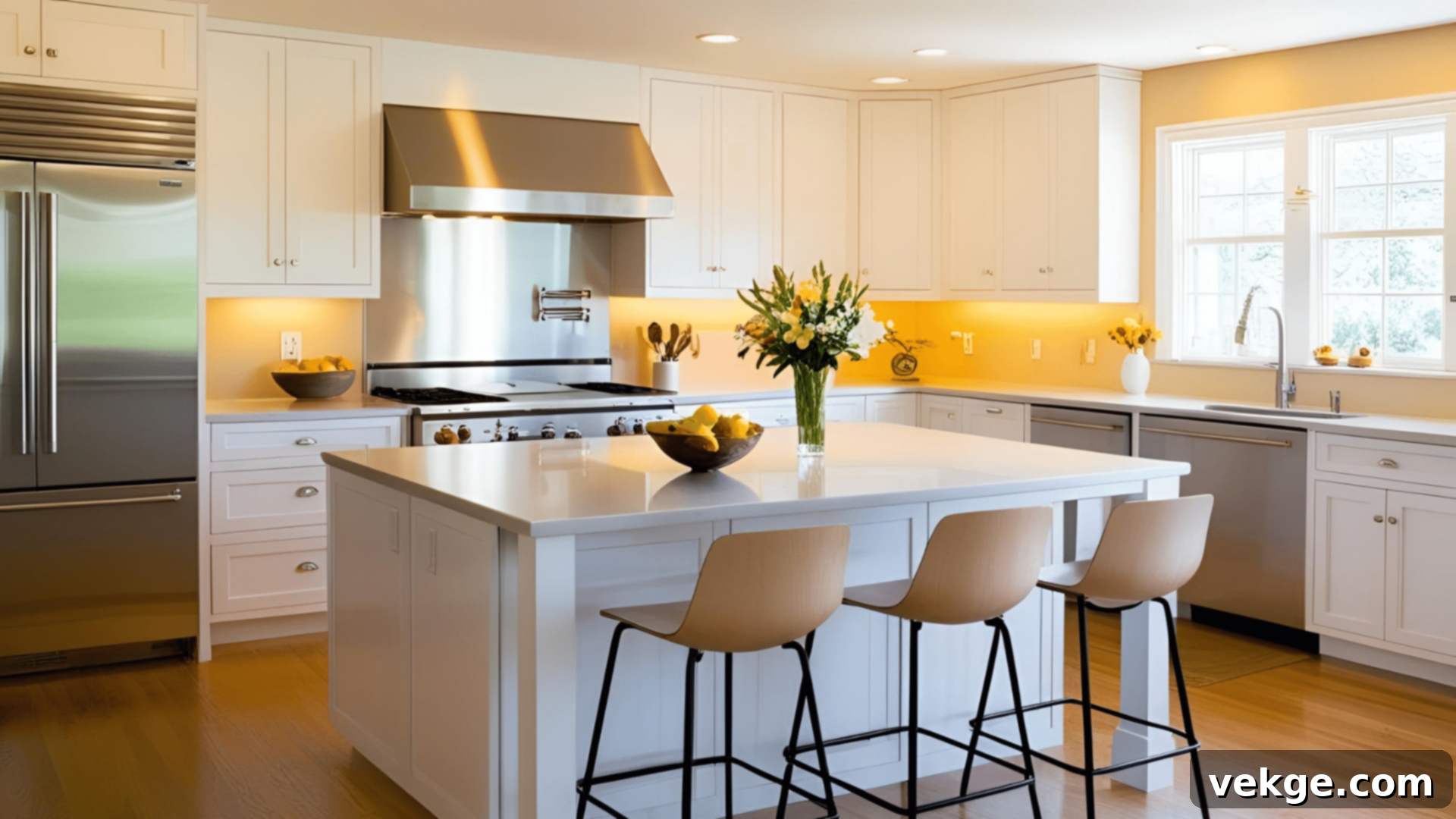Boost Your Home’s Value: 17 Essential Kitchen Staging Ideas to Sell Faster
The kitchen isn’t just a place to cook; it’s often the emotional heart of a home and a pivotal factor for potential buyers. When selling your property, a well-staged kitchen can create an immediate, powerful impression, making the entire home feel more inviting, spacious, and, crucially, more valuable. Buyers frequently prioritize the kitchen when making purchasing decisions, and a clean, updated, and well-organized space can significantly set your home apart in a competitive market.
The good news is that transforming your kitchen doesn’t have to break the bank. Many high-impact staging strategies are surprisingly cost-effective, offering an excellent return on investment. Simple updates can dramatically enhance its appeal, helping you attract more offers and potentially sell your home faster and for a higher price. Here are 17 proven, budget-friendly kitchen staging ideas designed to help you make a lasting impression and secure that sale.
Transformative Kitchen Staging Ideas That Attract Buyers
1. Deep Clean Everything
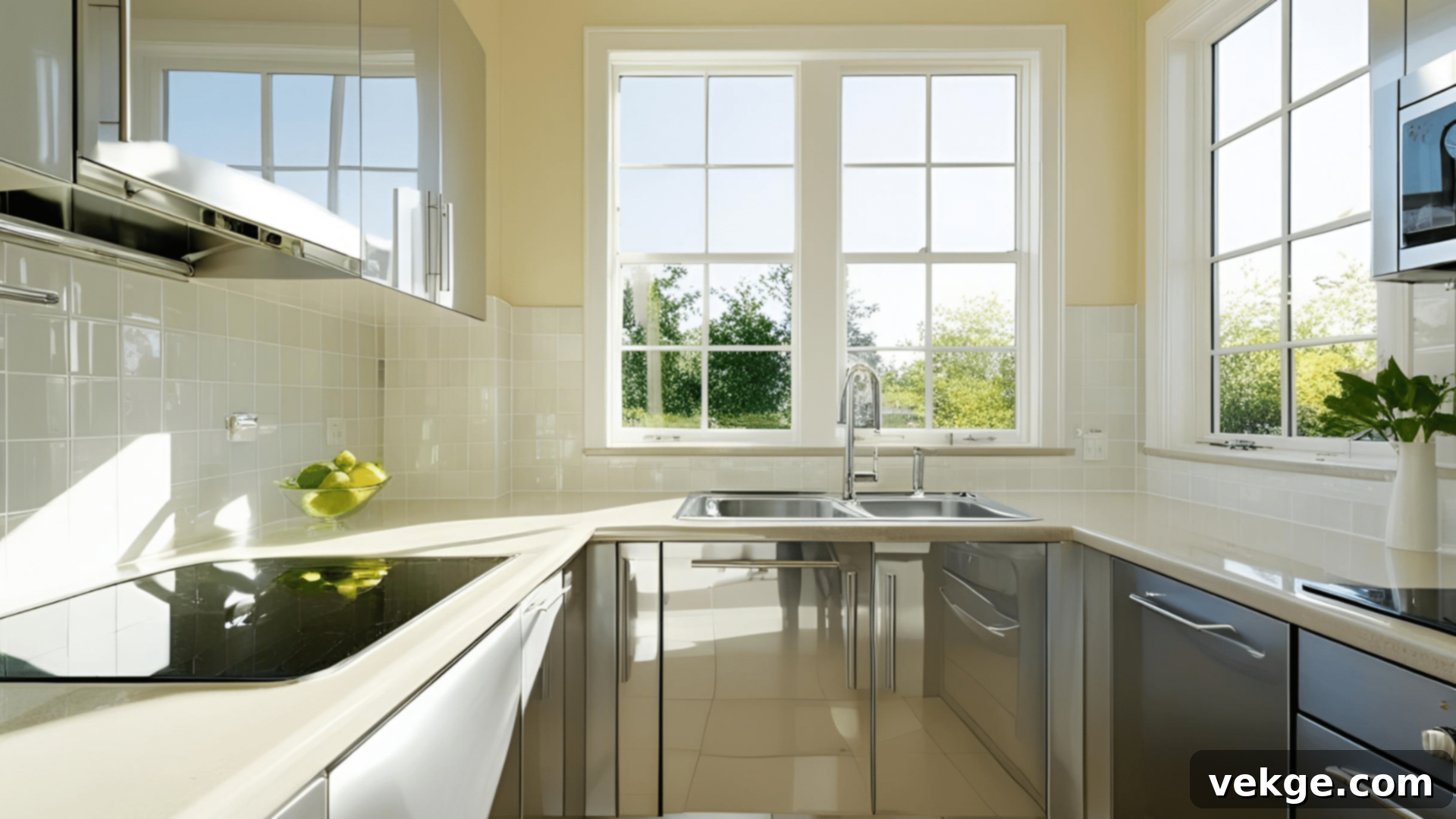
A pristine, spotless kitchen immediately signals to buyers that the home has been meticulously cared for and maintained. This perception of cleanliness extends throughout the entire property, subtly reassuring buyers about the home’s overall condition.
- Professional Cleaning Benefits: While DIY cleaning is good, hiring a professional cleaner ensures that no detail is overlooked. Experts have the tools and techniques to tackle every nook and cranny, from stubborn grease on vent hoods and backsplash grout lines to the often-forgotten interior of appliances like ovens and microwaves. Their thoroughness guarantees a truly sparkling finish that often exceeds what a homeowner can achieve alone.
- Key Areas to Focus On: Pay meticulous attention to high-touch and visible surfaces. This includes scrubbing sinks until they gleam, polishing countertops to a shine, degreasing cabinet exteriors, and ensuring floors are immaculate. Don’t forget stainless steel appliances, which should be streak-free, and glass surfaces, which need to be crystal clear. Also, wipe down baseboards, light fixtures, and window sills.
- Methods for Tackling Stubborn Stains: For persistent grease and grime, a paste made from baking soda and vinegar can work wonders. Apply, let it sit, and then scrub away. A ‘magic eraser’ sponge is excellent for removing scuff marks, crayon, or minor blemishes from painted cabinets and walls without damaging the finish. Specialized degreasers and limescale removers can be used for specific problem areas, ensuring every surface is pristine.
2. Clear the Countertops
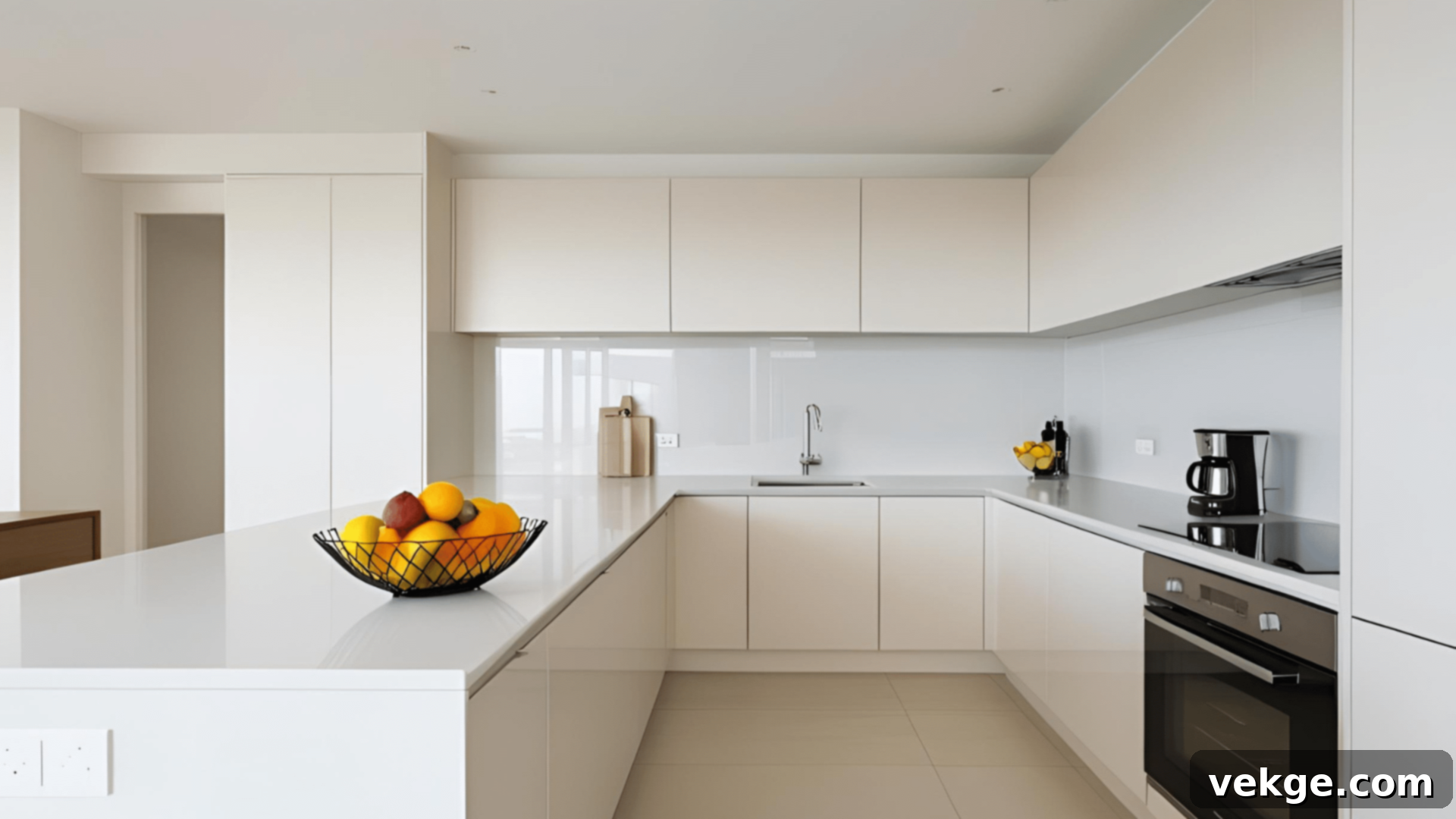
Countertops are prime real estate in a kitchen. A clutter-free surface makes the kitchen appear significantly larger, more organized, and more inviting, allowing buyers to envision their own belongings and lifestyle in the space.
- What to Remove Completely: To achieve a clean, expansive look, remove all non-essential items. This includes small appliances that aren’t aesthetically pleasing (toasters, blenders, stand mixers), stacks of mail, paperwork, dish drying racks, excessive spice jars, and any personal decorative items. The goal is a minimalist presentation that highlights the counter space itself.
- The Few Items That Can Stay: Strategic styling allows for a few carefully selected items. A stylish fruit bowl brimming with fresh, colorful produce (lemons, apples, oranges), a high-end coffee maker or espresso machine, or a simple, elegant cutting board leaned against the backsplash can add a touch of warmth and functionality without overwhelming the space. Choose items that evoke a sense of modern living or gourmet cooking.
- Creating Visual Space and Flow: Empty surfaces psychologically expand the kitchen, making it feel more functional and spacious. This helps buyers mentally “move in,” envisioning their own routines and how they would utilize the available space. A clear line of sight across countertops creates a sense of flow and openness that is highly appealing.
3. Organize Cabinet Interiors
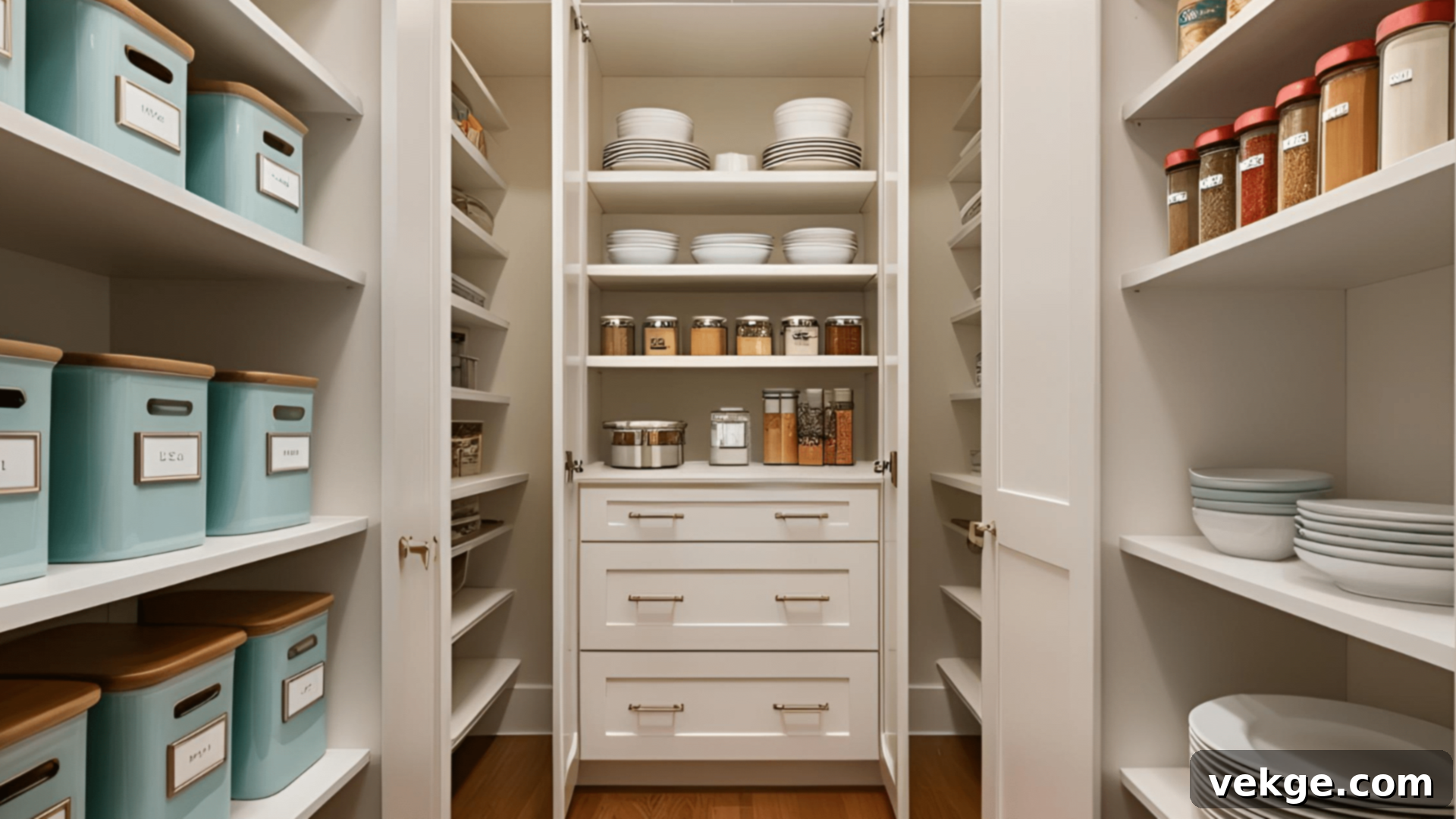
Savvy buyers frequently open cabinets and pantries to assess the available storage space. An organized interior speaks volumes about a well-maintained home and offers a glimpse into how comfortably their belongings might fit.
- Why Buyers Check Storage Spaces: Buyers are not just looking at the size of the kitchen; they’re evaluating its functionality. Organized cabinets and pantries suggest that the current homeowner takes pride in their home and that there is indeed ample, usable storage for their own kitchen essentials, food, and dishes. It removes any doubts about storage capacity.
- Container Systems and Organization Methods: Implement simple, effective organization. Use matching bins, clear containers, or even simple labels to store pantry items neatly. Stack plates and bowls uniformly, arrange spices in an orderly fashion, and ensure pots and pans are stacked efficiently. Drawer dividers can keep cutlery and utensils tidy.
- Creating Breathing Room on Shelves: Resist the urge to overstuff cabinets. Instead, remove about 20-30% of your items and arrange the remaining ones with care. Leaving some visible space on shelves makes storage look more generous and less cramped, allowing buyers to imagine that their own items will fit comfortably without clutter.
4. Update Cabinet Hardware
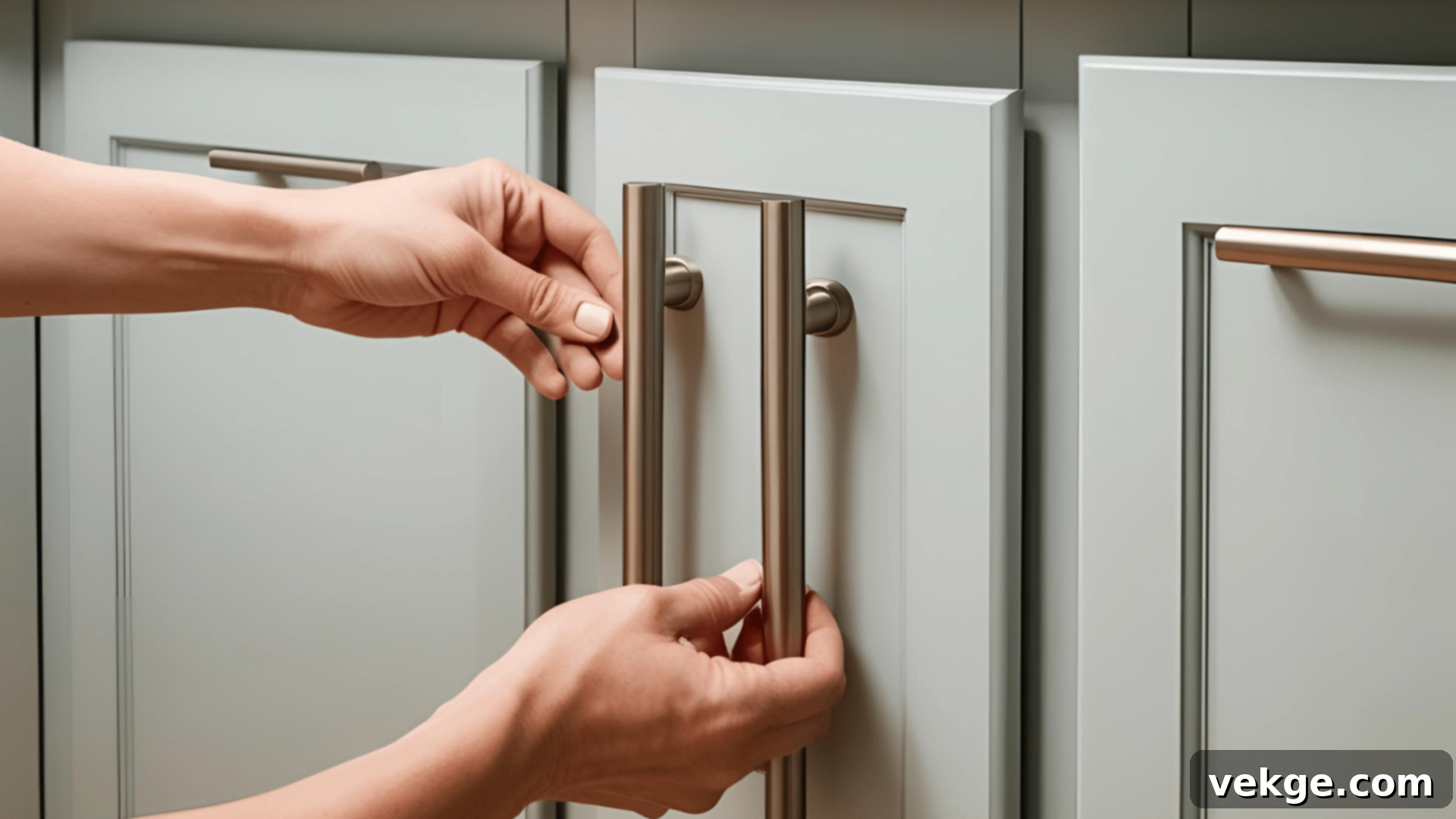
Think of cabinet hardware as the jewelry of your kitchen. Replacing outdated knobs and pulls is one of the most cost-effective ways to give cabinets an instant, modern facelift without the expense or hassle of a full renovation.
- Low-Cost, High-Impact Changes: A simple swap from worn, brassy, or builder-grade hardware to a contemporary finish can completely change the perception of your kitchen. Popular choices include sleek brushed nickel, bold matte black, or elegant gold finishes, which offer a sophisticated update for minimal cost.
- Current Styles That Appeal to Buyers: Modern buyers are often drawn to sleek, minimalist designs. Think simple bar pulls or discreet round knobs. Warm metallics like brushed brass or champagne bronze can add a touch of luxury, while classic matte black offers a contemporary industrial edge. Opt for styles that complement the overall aesthetic of your home and have broad appeal.
- Simple Installation Tips: This is a straightforward DIY project. The easiest approach is to choose new hardware that has the same screw placement as your existing pieces, minimizing the need for drilling. If new holes are required, use a template or measuring tape to ensure proper alignment and consistency across all cabinets for a professional finish.
5. Fresh Paint for Walls and Cabinets

A fresh coat of paint has an incredible transformative power, instantly making an outdated or tired kitchen feel bright, clean, and brand new. It’s an investment that yields significant visual impact.
- Best Neutral Colors for Kitchens: To appeal to the widest range of buyers, stick to neutral palettes. Soft whites (like off-white or creamy white), light grays (from cool silver to warm greige), and warm beiges create a clean, modern, and expansive look. These colors provide a versatile backdrop for buyers to envision their own style without feeling overwhelmed by a specific aesthetic.
- Cabinet Painting Techniques: Painting cabinets yourself requires patience but is highly rewarding. Start by thoroughly cleaning and degreasing surfaces. Lightly sand to create a good adhesion surface, then apply a high-quality primer. Follow with multiple thin coats of durable cabinet-specific paint, ensuring each coat dries completely before applying the next. Remove doors and hardware for the best results.
- Quick-Drying Options for Tight Schedules: If you’re on a strict timeline, look for fast-drying latex paints designed for cabinets. Some brands offer self-leveling formulas that minimize brush strokes. Additionally, spray paint options (with proper ventilation and masking) can speed up application and provide a smooth finish, making the process quicker without sacrificing quality.
6. Replace Outdated Light Fixtures

Lighting is more than just illumination; it dramatically affects the kitchen’s ambiance, perceived size, and overall functionality. Outdated fixtures can instantly date a kitchen, while modern ones brighten and uplift the space.
- Impact of Good Lighting: Bright, layered lighting can make a kitchen feel much larger, more welcoming, and more functional. Combine ambient (overhead), task (under-cabinet, pendants), and accent lighting to create a well-lit and inviting environment. Ensure all bulbs are of the same color temperature (warm white or natural daylight) for a cohesive look.
- Budget-Friendly Replacement Options: You don’t need expensive chandeliers. Consider sleek pendant lights over an island or peninsula for a contemporary focal point. Modern track lighting offers flexibility and style, while affordable under-cabinet LED strips can provide excellent task lighting and highlight your backsplash without significant cost. Flush-mount or semi-flush-mount fixtures can also offer a significant upgrade.
- Strategic Fixture Placement: Think about how the kitchen is used. Install task lighting directly over workspaces like the sink, stove, and prep areas. Use accent lighting to highlight key features, such as a beautiful backsplash or open shelving. Dimmers are also a great addition, allowing buyers to control the mood and brightness, adding a touch of sophistication.
7. Add Strategic Accessories
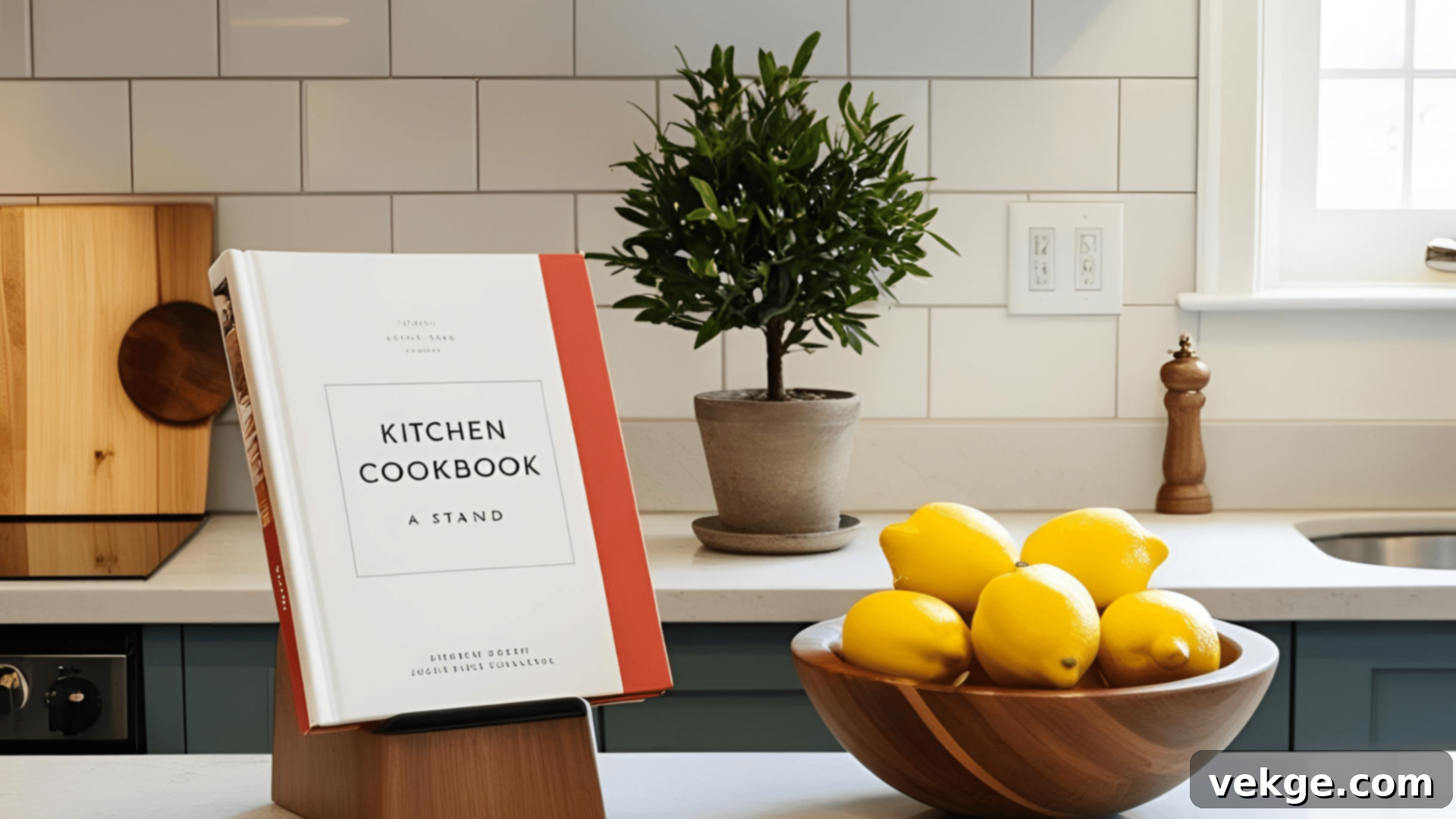
When staging, less is often more. Minimal yet thoughtfully placed accessories can add significant charm, character, and warmth to a kitchen without creating clutter or overwhelming the space.
- Cookbook Display Ideas: Select one or two visually appealing cookbooks with attractive covers. Display them open to a beautiful recipe page on a stand, or neatly stacked with a small plant on top. This suggests a love for cooking and home life.
- Fresh Fruit Arrangements: A simple, elegant wooden bowl, ceramic dish, or clear glass vase filled with fresh, vibrant fruit (e.g., a pile of bright lemons, green apples, or a mix of seasonal produce) adds a natural pop of color, freshness, and a welcoming feel.
- Coffee Station Setup: Create a mini coffee station. Arrange a neatly organized tray with a high-end coffee maker, a couple of stylish mugs, and small, attractive containers for sugar or cream. This creates a cozy, lifestyle-oriented vignette that helps buyers envision their morning routine.
8. Create a Small Vignette
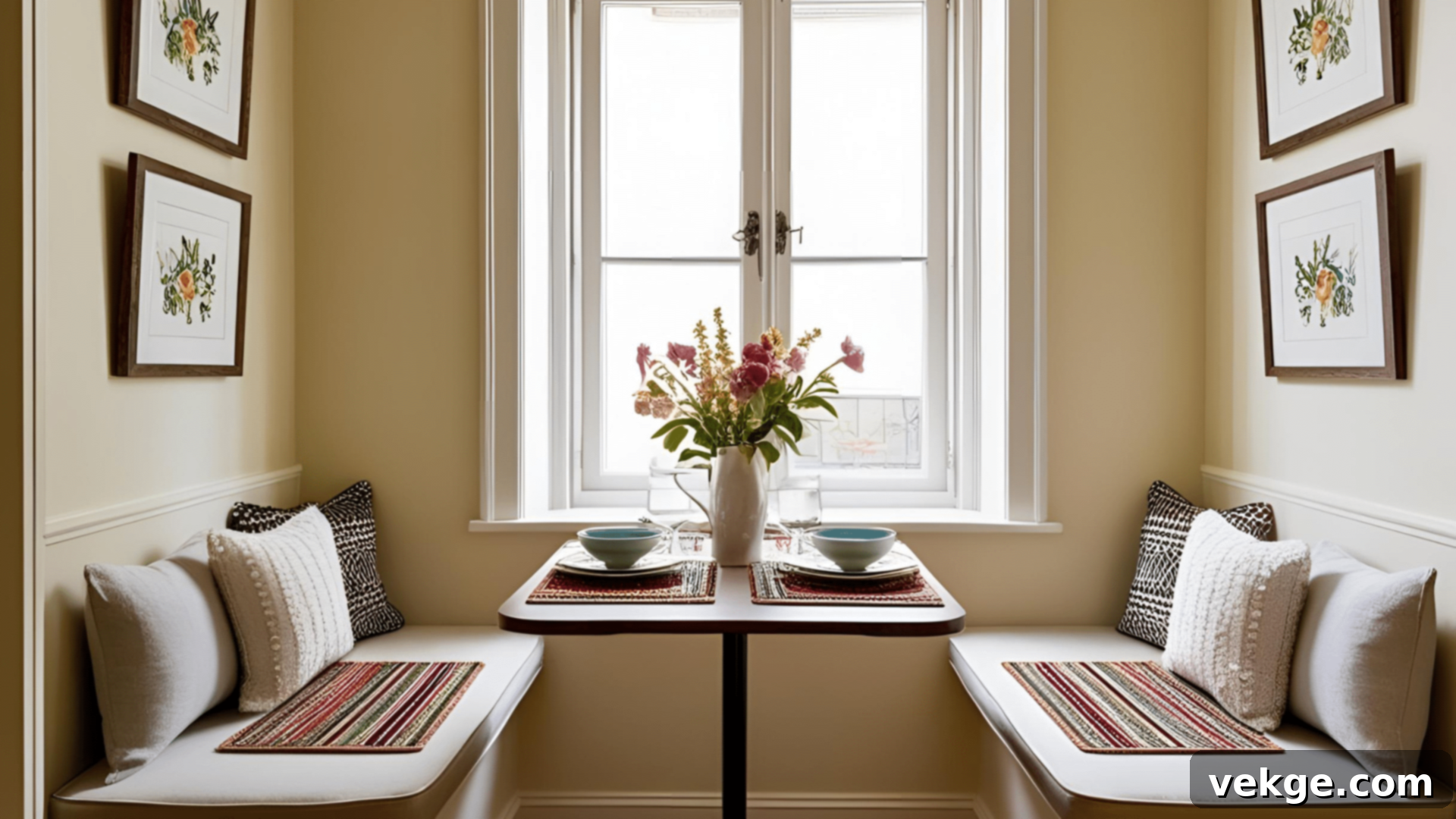
Vignettes are small, artfully arranged scenes that tell a story and encourage buyers to imagine themselves enjoying the space. Thoughtful staging helps them make that crucial emotional connection.
- Breakfast Nook Staging: If you have a breakfast nook, set a small table with stylish placemats, a simple place setting (a single plate, napkin, and fork), a vase of fresh flowers, and perhaps a small, attractive pastry or croissant. This paints a picture of relaxed morning meals.
- Island Styling Concepts: Transform your kitchen island into a focal point. Place a decorative tray featuring a chic candle, a small potted herb or succulent, and one or two curated items like an interesting bowl or a beautiful cutting board. This makes the space feel ‘lived-in’ but aspirational.
- Visual Storytelling Through Design: Each vignette should communicate a subtle lifestyle message. Keep the look balanced, intentional, and cohesive with the overall home style. Showcase how the space can be used functionally (e.g., a cutting board with a knife) and beautifully (e.g., a vase of flowers), encouraging buyers to imagine their own life unfolding there.
9. Bring in Plants or Fresh Herbs
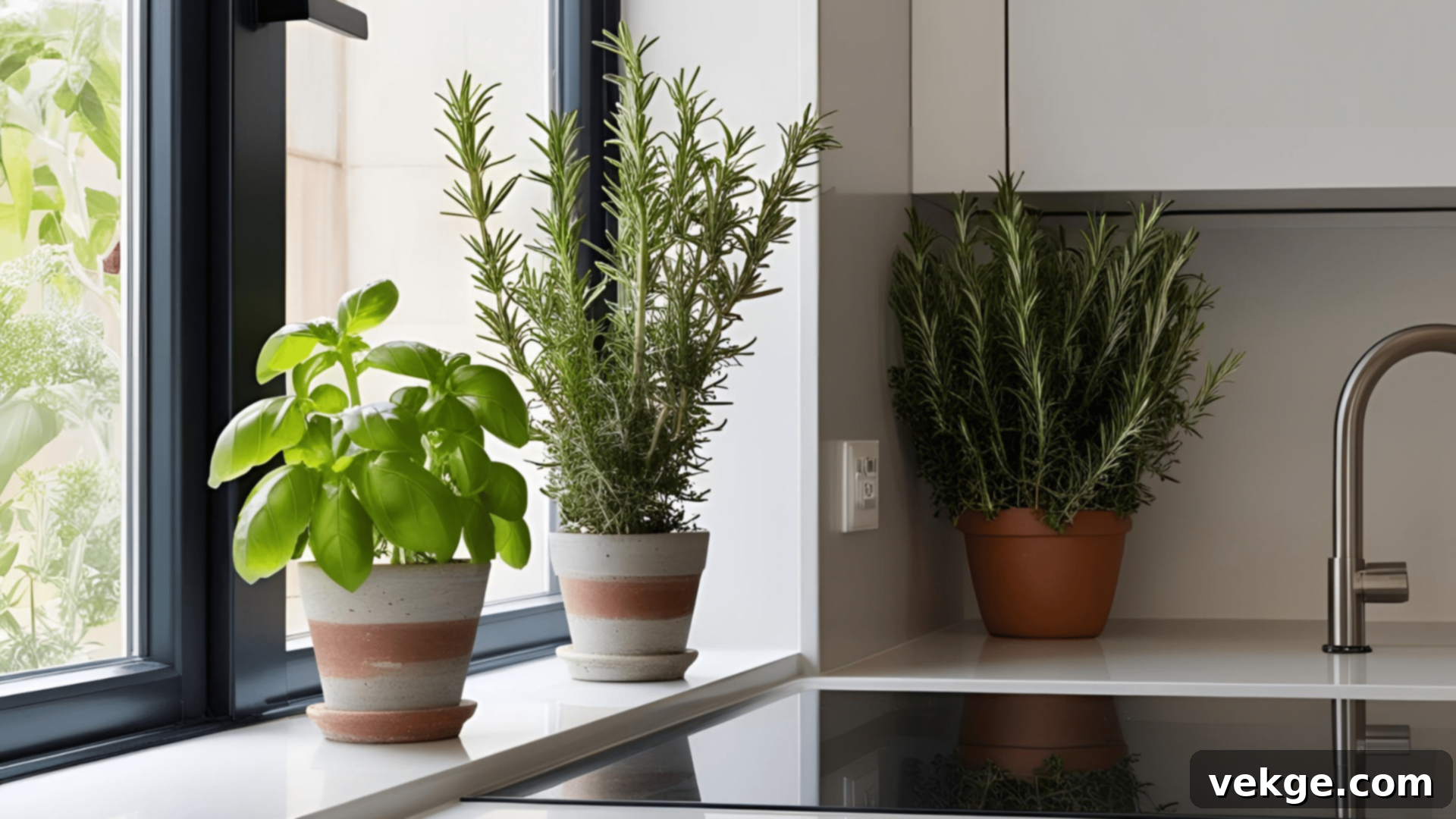
Introducing living greenery immediately makes the kitchen feel fresher, more vibrant, and undeniably more inviting. Plants add a touch of life and natural color that can soften the sometimes-hard lines of a kitchen.
- Low-Maintenance Options: Opt for plants that thrive indoors with minimal care and won’t wilt quickly. Fresh culinary herbs like basil, rosemary, or mint in small pots are perfect as they also suggest culinary prowess. Succulents or small, hardy houseplants like pothos are also excellent, low-commitment choices.
- Placement Ideas: Strategically place small potted herbs near the kitchen sink, on a sunny window sill, or as part of an island vignette. A slightly larger vase of fresh-cut greenery (like eucalyptus) can add height and drama to the island or dining table. A hanging plant in a corner can also soften the space and draw the eye upwards.
- Adding Life to the Space: Plants bring an organic element that contrasts beautifully with kitchen materials like stainless steel and stone. They add a much-needed pop of color and warmth, creating a more welcoming and harmonious atmosphere that appeals to buyers seeking a vibrant living space.
10. Refresh Window Treatments
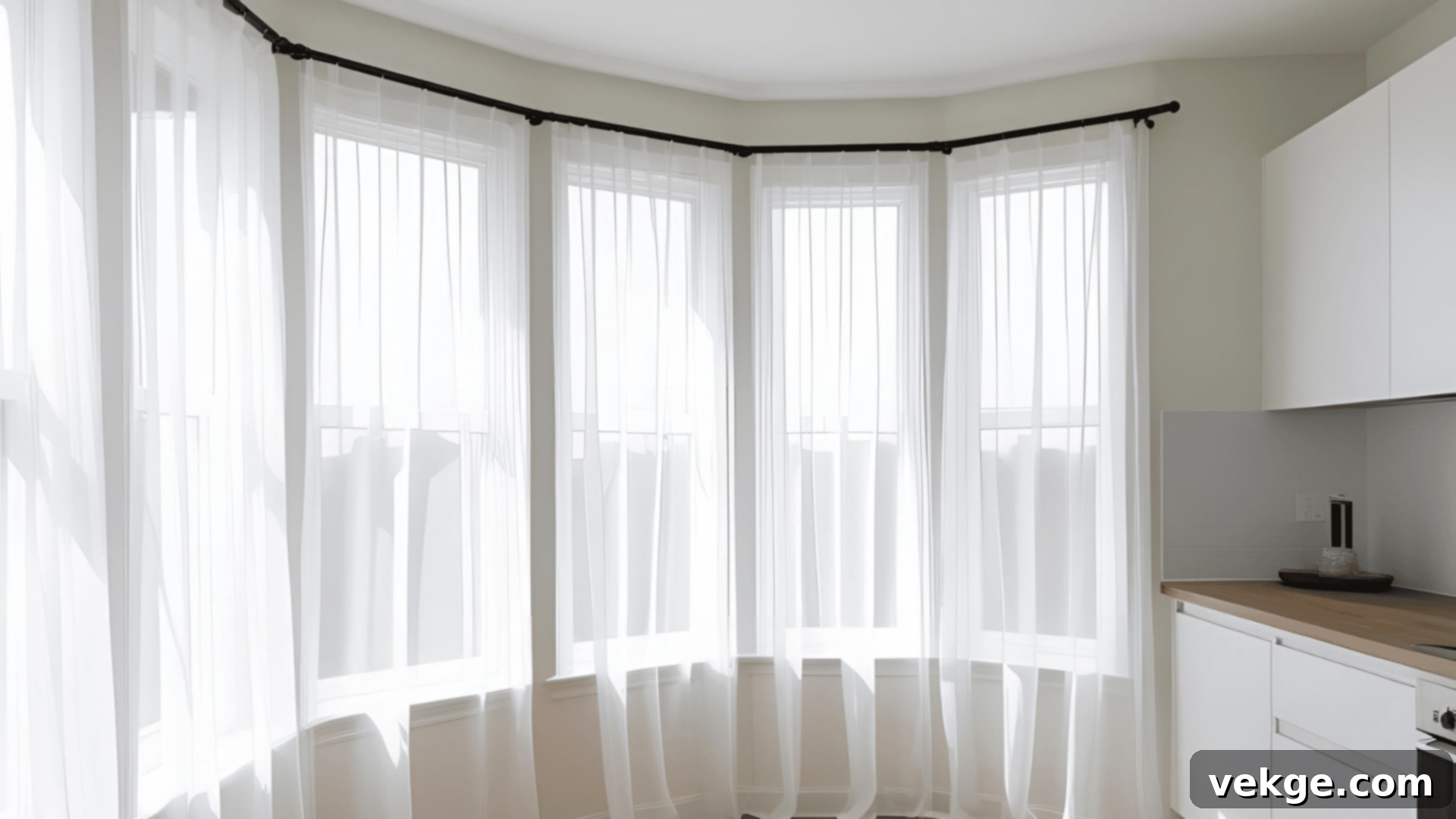
Windows are essential for natural light. Outdated or heavy window treatments can make a kitchen feel dark and small, while refreshed options enhance natural light and create an open, airy feel.
- Maximizing Natural Light: The primary goal is to let in as much natural light as possible. Use sheer curtains, light-colored Roman shades, or blinds that can be fully opened and drawn back to expose the entire window. Remove any heavy drapes that block light.
- Simple, Clean Options: Stick to neutral-colored roller shades, white wooden or faux-wood blinds, or simple, unpatterned sheer curtains. These options provide a crisp, clean look that complements almost any kitchen style and doesn’t distract from the overall space.
- When to Remove Treatments Completely: If your windows are large, in good condition, and offer an unobstructed, appealing view (and privacy isn’t a concern for showings), consider removing window treatments entirely. This can make the space feel even bigger, brighter, and more connected to the outdoors.
11. Update the Backsplash

A backsplash is a prominent feature that can dramatically influence the kitchen’s aesthetic. A refreshed backsplash instantly adds modern style and personality without requiring a full, costly renovation.
- Temporary Solutions: For a quick and affordable update, consider high-quality peel-and-stick tiles. These come in a variety of styles, from classic subway tile to more contemporary geometric patterns, and can be installed over existing surfaces. Contact paper with a tile or stone pattern can also provide a temporary, modern look.
- Neutral Options for Broad Appeal: To appeal to the widest audience, opt for neutral colors and timeless patterns. White subway tiles are a classic for a reason, offering a clean and bright look. Light gray tones, soft beige blends, or subtle marble patterns also work well, allowing buyers to easily envision their own decor.
- Easy Installation Methods: Peel-and-stick options require no grout or specialized tools, making them an ideal DIY project that can be completed in a single day. Ensure the surface is clean, dry, and smooth before application for the best results and a professional appearance.
12. Address Floor Issues
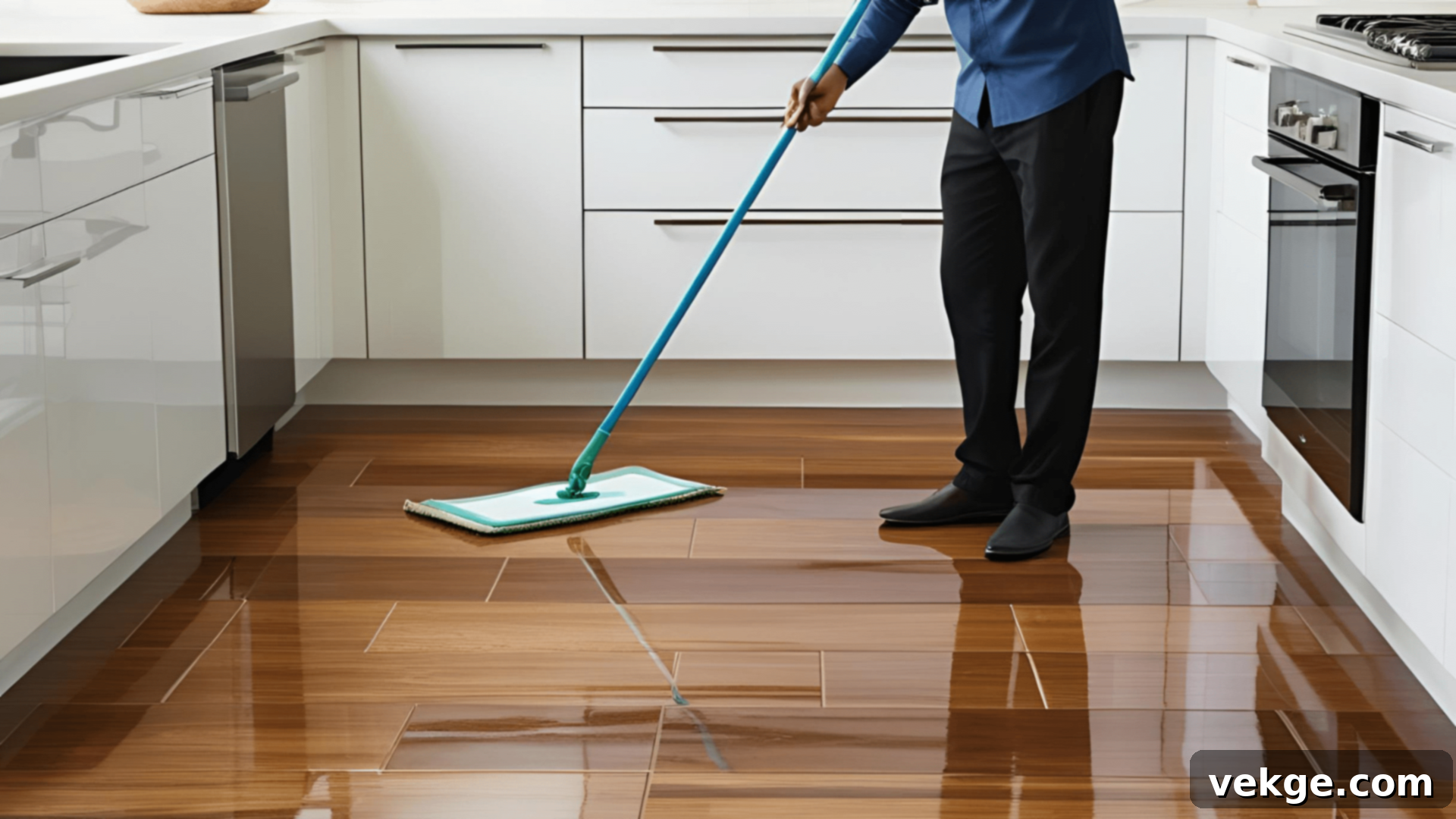
Kitchen flooring receives a lot of traffic and wear, so buyers definitely notice its condition. Ensuring it’s clean, well-maintained, and free of obvious damage is crucial for a positive impression.
- Deep Cleaning Techniques: For tile floors, thorough scrubbing and steam cleaning can make grout lines look brand new. For hardwood, use a specialized hardwood cleaner to remove grime and restore shine. Ensure laminate or vinyl floors are free of scuffs and have a consistent sheen.
- Quick Fixes for Damaged Areas: Minor scratches on wood floors can be concealed with wood markers or touch-up kits. Small chips in tile might be filled with matching grout repair kits. For more noticeable, but still minor, damage, strategically placed small rugs in high-traffic areas can disguise imperfections while adding warmth and style.
- Budget Floor Covering Options: If your existing flooring is beyond simple repair, budget-friendly covering options exist. Peel-and-stick vinyl tiles or luxury vinyl plank (LVP) can be installed over many existing floors for a significantly updated look. Alternatively, a large, neutral area rug can define a space and cover unsightly flooring without the commitment of a full replacement.
13. Style the Sink Area
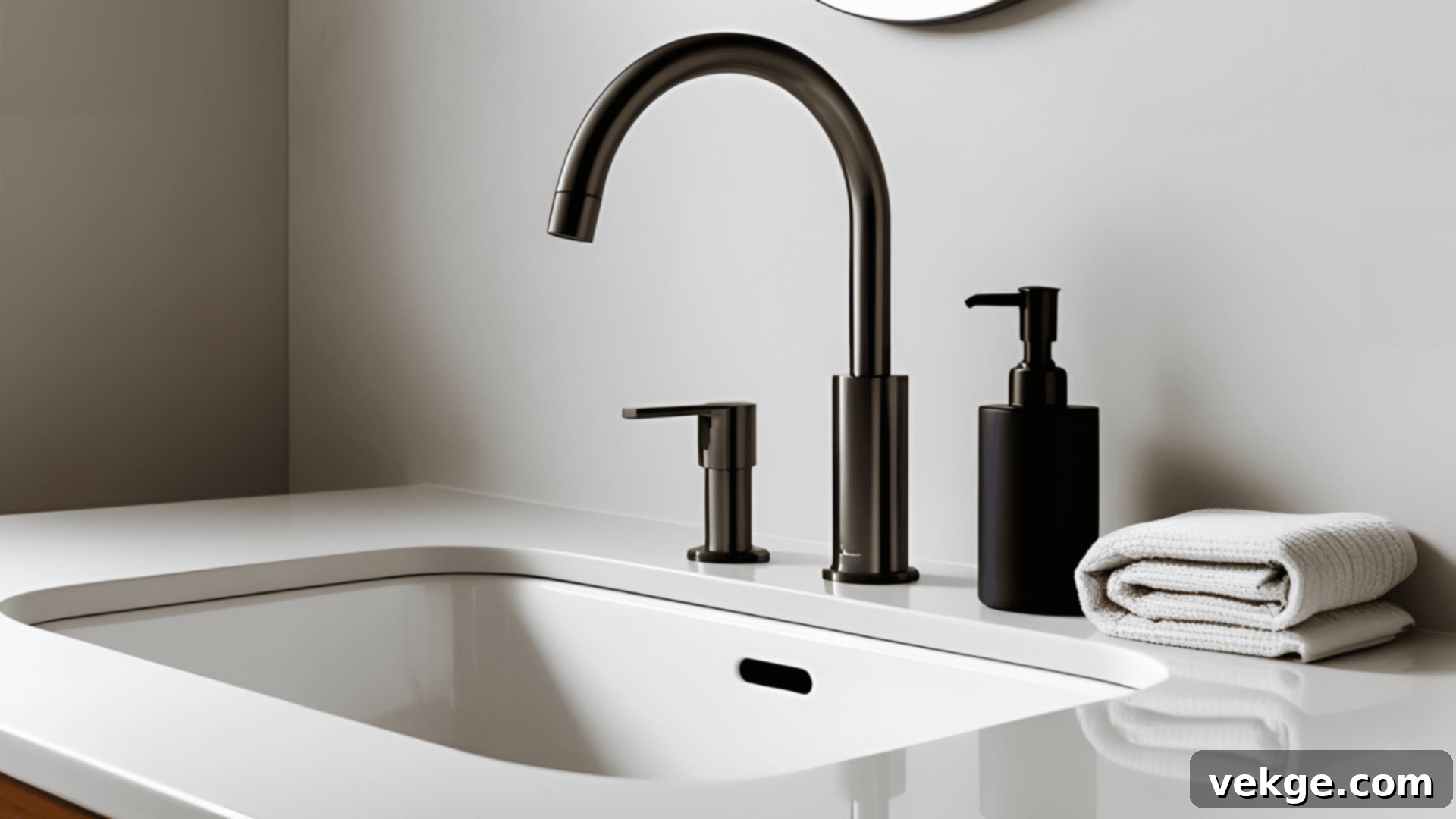
The sink area is a central point of activity and often the first thing buyers notice. A clean, organized, and stylish sink space leaves a significant and positive lasting impression.
- Clean Soap Dispensers and Trays: Ditch the mismatched dish soap bottle. Instead, use a simple, elegant matching soap dispenser (ceramic, glass, or stainless steel) and keep it immaculately clean. A small, decorative tray underneath can catch drips and add a touch of sophistication.
- Hiding Cleaning Supplies: Sponges, scrubbers, and dishcloths can quickly create clutter. Store them neatly out of sight under the sink in a small caddy or drawer. The only items visible should be the chosen soap dispenser and perhaps a small, neatly folded hand towel.
- Faucet Update Options: Replacing an old, leaky, or dated faucet with a sleek, modern design can instantly update the entire sink area and add a touch of luxury. Popular choices include pull-down spray faucets in brushed nickel, matte black, or chrome, which are both functional and aesthetically pleasing.
14. Remove Personal Items

While your personal touches make a house a home for you, a neutral kitchen is paramount for staging. It helps potential buyers picture themselves living there, allowing them to project their own style and memories onto the space.
- What to Pack Away Now: Begin by removing all personal photos, children’s artwork, magnets, and personal notes from the refrigerator. Also, put away any highly niche decorations, religious items, or family memorabilia that might distract or make a buyer feel like an intruder.
- Creating a Neutral Space: The goal is universal appeal. Stick to simple, universally appealing decor that is tasteful but not overly specific. Think clean lines, natural textures, and a limited color palette. This allows the kitchen’s features to shine without personal distractions.
- Helping Buyers Envision Themselves: A depersonalized and neutral setting provides a blank canvas. When buyers don’t see your life reflected everywhere, it’s easier for them to mentally “move in” and visualize their own family dinners, morning routines, and entertaining in the kitchen. This emotional connection is key to a faster sale.
15. Fix Minor Issues
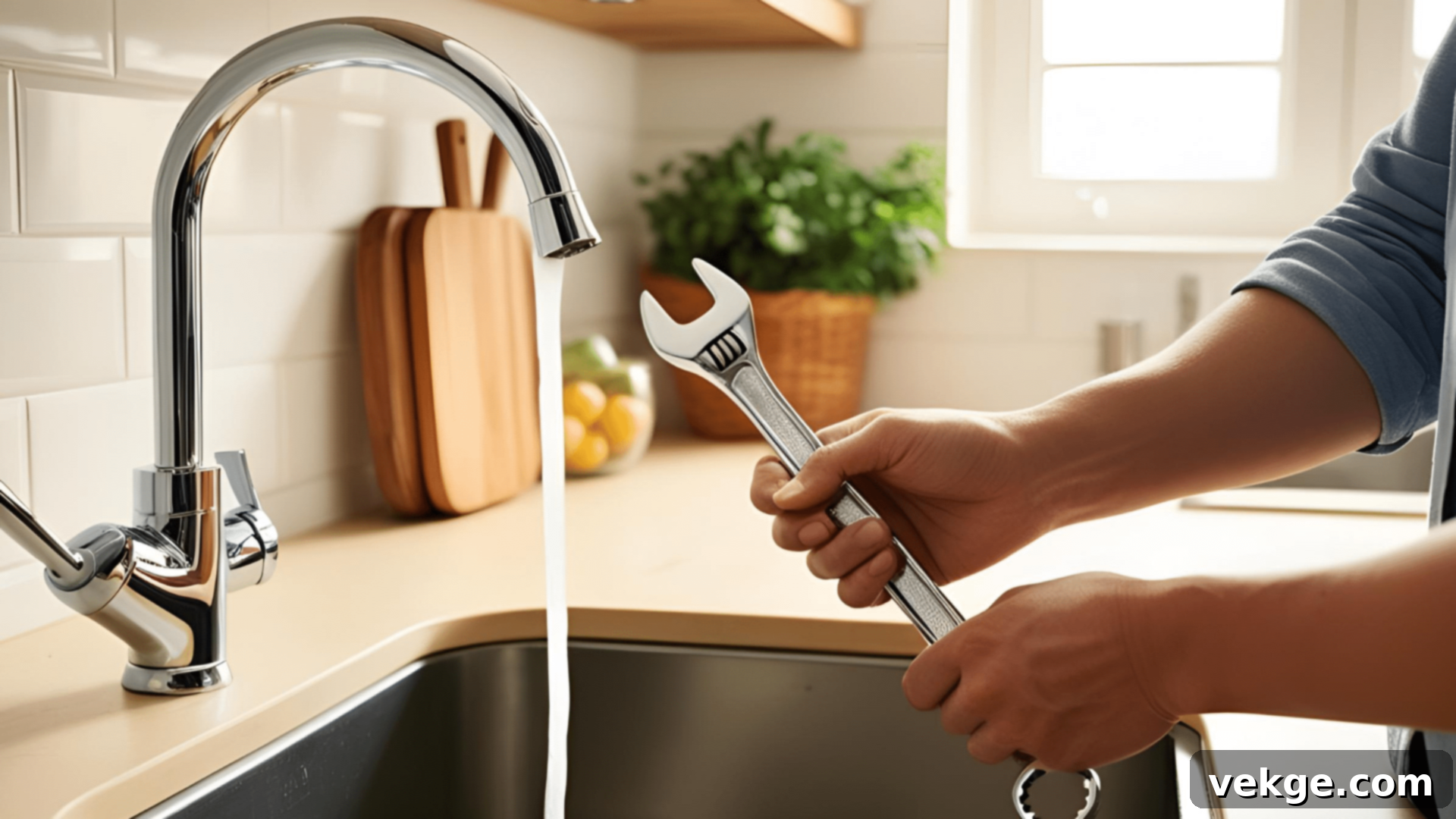
Small, seemingly insignificant repairs can make a big difference in how buyers perceive your kitchen. Addressing these minor issues prevents buyers from seeing the kitchen as outdated, neglected, or poorly maintained, which can lead to lower offers.
- Leaky Faucets and Drips: A persistent drip or a leaky faucet can suggest plumbing problems, triggering alarm bells for buyers. Repair any plumbing issues before showings; it’s a quick fix that avoids raising concerns about hidden costs.
- Cabinet Alignment Fixes: Misaligned cabinet doors or drawers can make a kitchen look cheap or carelessly maintained. Adjust hinges to ensure all cabinet doors close smoothly and align perfectly. This provides a polished, high-quality appearance.
- Hardware Tightening: Loose handles and knobs on cabinets and drawers are annoying and can feel flimsy. Take a few minutes to tighten all hardware, ensuring they are secure and feel sturdy. This attention to detail conveys a sense of thorough maintenance.
16. Create Good Traffic Flow
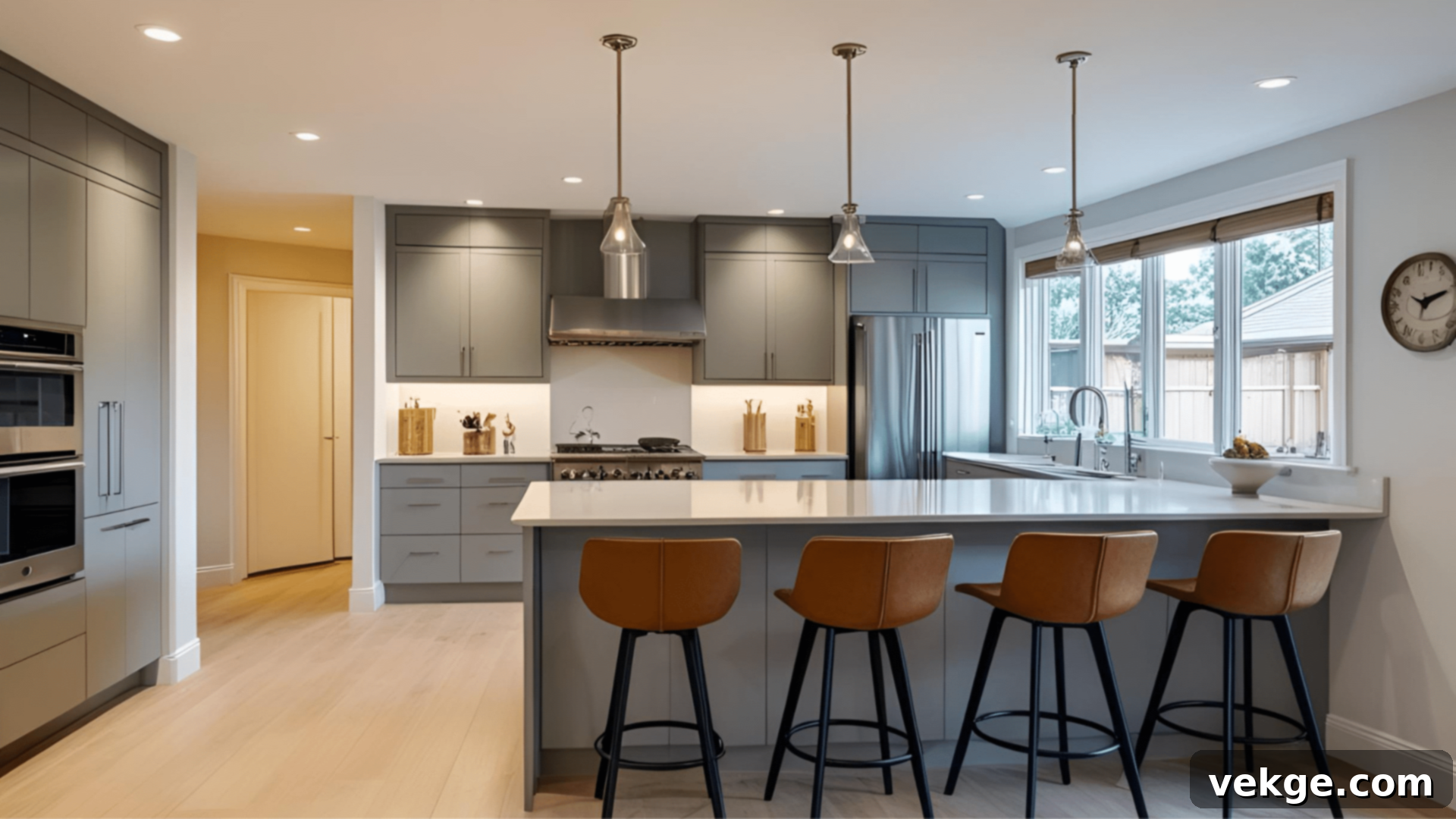
The layout and flow of a kitchen significantly impact its functionality and perceived spaciousness. A well-arranged kitchen makes movement effortless, enhances usability, and feels much more welcoming.
- Removing Obstacles: Identify and eliminate any furniture, rugs, or decorative items that obstruct natural pathways or make the kitchen feel cramped. Ensure there’s a clear, wide path from the entryway through the kitchen. Remove extra chairs or stools if they clutter walkways.
- Making Movement Easy: Arrange bar stools, dining tables, and chairs so that they don’t impede movement around key work areas (the “kitchen triangle” of sink, stove, and refrigerator). Buyers should be able to navigate the space easily and comfortably, without bumping into anything.
- Highlighting Work Areas: While keeping things clear, you can subtly define prep spaces. A well-placed cutting board next to the sink, or a small plant on a clear section of the counter, can hint at functionality without adding clutter. This shows the kitchen’s potential for cooking and entertaining.
17. Last-Minute Showing Tips
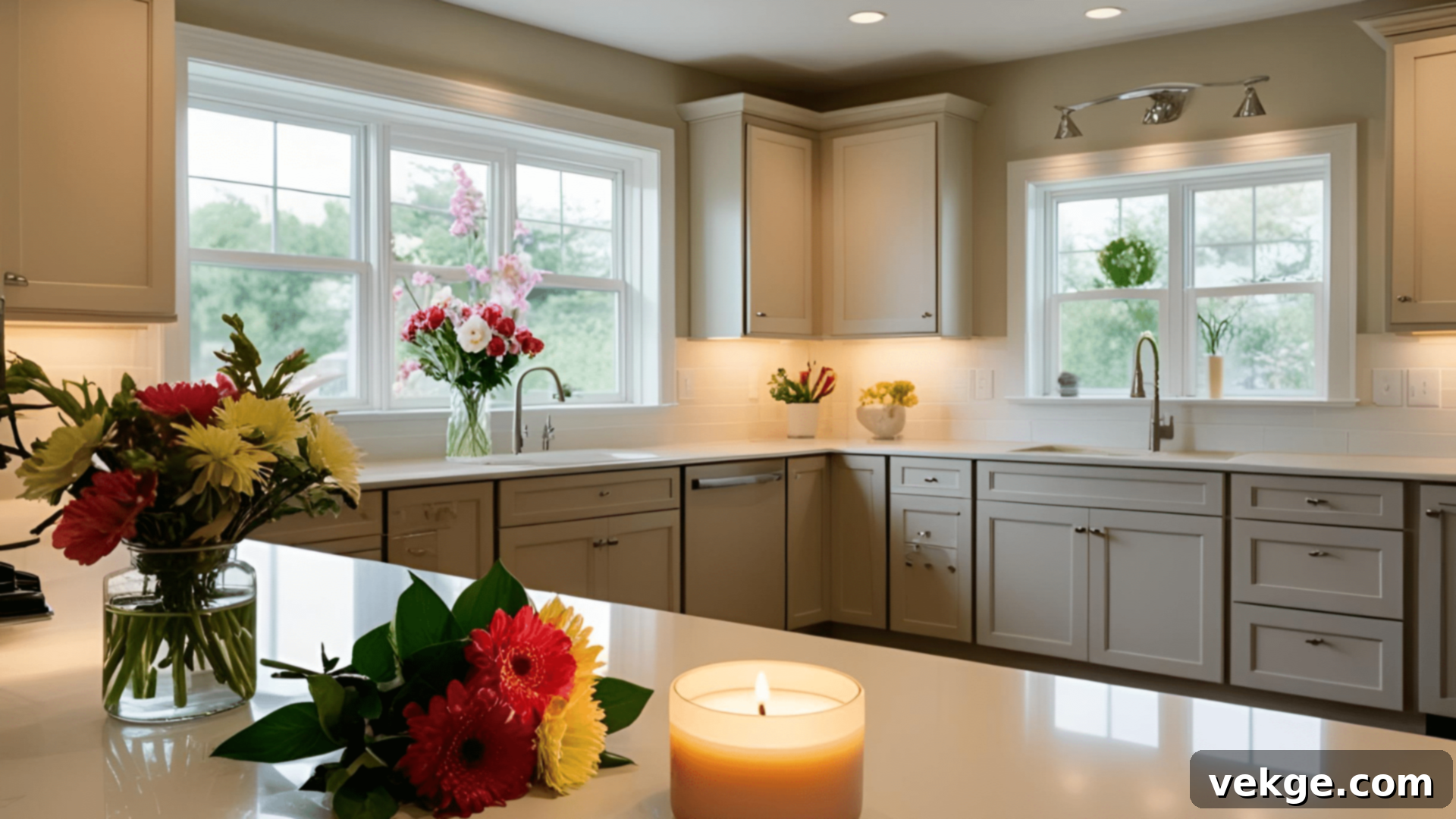
The final touches just before potential buyers arrive can make all the difference, creating an immediate and overwhelmingly positive impression that transforms a good kitchen into an unforgettable one.
- Quick Cleaning Checklist: Just before buyers arrive, do a swift once-over. Wipe down all countertops and the sink, quickly sweep or vacuum the floors, and empty the trash can. Ensure all appliance surfaces are fingerprint-free. A clean smell enhances this.
- Subtle Scent Additions: A welcoming aroma can trigger positive emotions. Light a lightly scented candle (vanilla, citrus, or a clean linen scent) about 30 minutes before the showing, or brew a fresh pot of coffee. Baking a batch of cookies or cinnamon rolls can create an irresistibly homey and inviting atmosphere. Avoid overpowering or artificial scents.
- Final Staging Touches: Adjust all lighting to its optimal setting, ensuring the kitchen is bright and inviting. Fluff any towels (hand towels by the sink, dish towels on the oven handle) and ensure they are neatly folded. Check that all chosen accessories are perfectly in place, window treatments are open, and everything looks picture-perfect.
How to Choose the Right Staging Approach for Your Kitchen
Assessing Your Kitchen’s Strengths and Weaknesses
Understanding your kitchen’s unique strengths and weaknesses is the foundational step in selecting the most effective staging approach. Begin by taking a critical, objective look at your space, perhaps even through the eyes of a stranger. Identify key features that are likely to appeal to buyers, such as abundant storage options, exceptional natural light, high-end appliances, a spacious island, or an open-concept layout. These are the elements you’ll want to highlight and emphasize.
Simultaneously, candidly address any problem areas. Is the cabinetry outdated or showing significant wear? Are the floors scuffed or discolored? Is the lighting dim or unattractive? Recognizing these areas allows you to prioritize impactful improvements. Often, simple updates like repainting cabinets, upgrading hardware, or even addressing minor repairs can create a surprisingly fresh and inviting look without the need for extensive, costly renovations. This assessment helps you focus your efforts where they will yield the greatest visual return.
Budget Considerations
Your budget will significantly influence your staging decisions, but rest assured, there are effective strategies for every price point. Even a modest budget can make a substantial impact.
- Low-Budget Staging (Under $200): Focus on simple yet highly effective changes. This includes a professional-level deep clean, thorough decluttering of all surfaces and cabinets, and adding fresh, vibrant elements like potted herbs or a stylish bowl of fruit. These actions can dramatically transform the perceived cleanliness and spaciousness of your kitchen with minimal financial outlay.
- Mid-Range Updates ($200 – $1,000): With a slightly larger budget, you can implement noticeable upgrades. This tier allows for replacing outdated cabinet hardware, installing a modern peel-and-stick backsplash, or updating old light fixtures to more contemporary styles. A fresh coat of neutral paint on the walls can also fall within this range, offering a significant visual refresh. These changes provide a strong visual upgrade without venturing into major renovation costs.
- Higher Budget Transformations ($1,000+): For those with more resources, you can consider more impactful changes. This might include refinishing or professionally repainting existing cabinets, upgrading countertops to a more modern material (like laminate or an entry-level quartz), or replacing one or two key appliances (e.g., an outdated stove or dishwasher) with newer, more energy-efficient models. These higher-tier updates can give the kitchen a completely new, high-end feel, making it an undeniable standout selling point for your home.
Timeline Planning
Effective kitchen staging requires careful planning, especially when considering your home sale timeline. Understanding how long each type of project takes can help you manage expectations and coordinate with real estate showings.
- Quick Fixes (1-3 Days): Tasks like deep cleaning, decluttering, organizing cabinet interiors, and adding strategic accessories (plants, fruit bowls) can typically be completed within a few days. These provide immediate appeal and are perfect for last-minute preparations before a showing.
- Moderate Updates (1-2 Weeks): Projects such as painting walls or cabinets, replacing cabinet hardware, updating light fixtures, and installing a peel-and-stick backsplash usually take one to two weeks, including drying times and installation. These updates offer a noticeable visual upgrade and significantly enhance perceived value.
- Larger Projects (1 Month+): More substantial changes like refinishing existing cabinets, installing new flooring, or upgrading countertops may take a month or more, especially if professional contractors are involved. While these require more time and investment, they can significantly boost the home’s marketability and potential selling price, making them worthwhile for a longer sale horizon.
By assessing the kitchen’s current condition, aligning with your budget, and planning according to your sales timeline, homeowners can make smart staging choices that not only attract a wide range of buyers but also contribute to selling their home faster and more profitably.
Maintenance Tips for Your Staged Kitchen
Keeping a staged kitchen in pristine, showing-ready condition requires consistent effort, but it’s crucial for maintaining that initial positive impression. Daily upkeep is your first line of defense: routinely wipe down countertops, sinks, and appliance surfaces to keep them spotless and fingerprint-free. Sweep and mop floors regularly to prevent dust and grime buildup. Remember to empty trash cans frequently and use neutral air fresheners or diffusers to manage any lingering cooking odors, opting for light, clean scents over overpowering ones.
Before every showing, conduct a rapid check. Spot-clean any smudges on appliances, ensure countertops are completely cleared, and verify that all lighting is on and optimized. Open blinds and curtains fully to flood the space with natural light. Re-fluff any decorative towels, ensure plants are fresh, and add small, inviting touches like a fresh bowl of fruit. To sustain this impeccably staged look, try to limit messy cooking before showings, always use your exhaust fan, and practice cleaning as you go. By staying consistent with these simple maintenance steps, you can ensure your kitchen always remains inviting, helping to accelerate your home sale.
Conclusion
Kitchen staging is undeniably one of the most effective strategies to boost a home’s appeal, significantly contributing to a faster sale and a better final price. It’s about more than just aesthetics; it’s about creating an experience and an emotional connection for potential buyers. If you’re working with tight timelines or a limited budget, focus your efforts on high-impact, low-cost strategies: a deep clean, thorough decluttering, and subtle updates to cabinet hardware or lighting can dramatically transform a space. These quick changes create a fresh, inviting, and spacious atmosphere that resonates with almost everyone.
For those with more resources, investing in refinishing cabinets, upgrading countertops, or replacing key appliances can provide an even stronger return on investment, elevating the kitchen to a true showpiece. Ultimately, a well-staged kitchen allows buyers to easily picture themselves living, cooking, and entertaining in the home, fostering that crucial sense of belonging. By prioritizing the most impactful updates and maintaining a pristine environment, sellers can enhance their kitchen’s appearance with minimal stress while maximizing their home’s market potential and securing a swift, successful sale.
